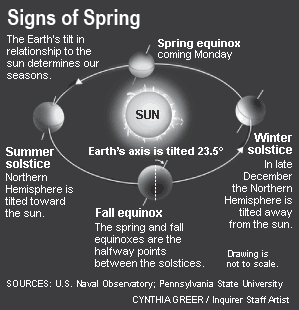So, you think you know when the vernal equinox is?
Shedding some light.
By Tom Avril
Inquirer Staff Writer
Ah, the first day of spring.
That mystical midpoint between winter and summer, when the Earth is tilted neither toward nor away from the sun. When daylight is poised, gloriously, to gain the upper hand over darkness.
Astronomers know it as the vernal equinox, which happens this year on Monday. And as anyone with a passing knowledge of Latin might guess, it's a day - one of two every year - when time is evenly divided between dark and light.
Except it isn't.
Sunrise occurs on Monday at 6:04 a.m. in Philadelphia. And sunset comes at 6:13 p.m. - 12 hours and a lexicologically incongruous 9 minutes later.
Meanwhile, there is a day when the sun actually will be up for exactly 12 hours.
Today.
What in the name of Apollo is going on?
Simply put, the sun is awfully big. So on the equinox - and on every other day, for that matter - the sun edges above the horizon a few minutes sooner than if it were just a point of light.
In addition, the sun's rays are refracted, or bent, as they penetrate the atmosphere, allowing us to see the sun before it's actually "there," said Christopher Palma, who teaches astronomy at Pennsylvania State University.
The same thing occurs when you stick a pencil in a glass of water. The pencil looks broken, because water refracts light differently than air.
Likewise, Earth's atmosphere refracts light differently than empty space. So we get a sort of celestial sneak preview every morning.
"We see the sun before it's technically above the horizon," Palma said.
There are other factors at play, but the size of the sun - more than 860,000 miles in diameter - and the fact that its rays are distorted are the two main reasons that equinoxes are not really "equi."
The size of the sun is responsible for about one-third of the effect; refraction two-thirds, Palma said.
Monday, though, is still the actual day when the Earth is halfway on its journey from winter to summer (or from summer to winter, if you're reading this south of the equator). The exact moment of the equinox occurs at 1:26 p.m.
The few extra minutes notwithstanding, it's still the first day of spring.
ONLINE EXTRA
Kids (and others): To see Earth in action around the sun, visit an interactive video at http://go.philly.com/equinox
